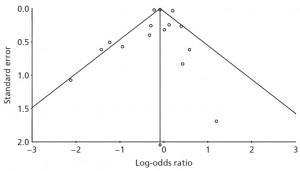
Here in the UK, if you’re caught in possession of class A drugs you could go to prison for up to 7 years. For dealing, it could mean a life sentence. And yet it’s been estimated that almost 6% of 20-24 year olds in England and Wales use class A drugs. While the link between class A drug use and criminal activity is not clearly defined, there certainly seems to be a link. Primarily for this reason, the societal cost of problematic class A drug use in England and Wales has been estimated to be over £15 billion.
Services for substance misuse in the UK primarily serve opiate and crack users, and so this is the focus of UK-based initiatives. In 2010, around 30% of people starting treatment did so via a criminal justice system referral. Funding for the UK’s Drug Interventions Programme (DIP) – the primary means of diversion – stood at around £91 million in 2012/13. That arguably leaves a lot of room for investment if that investment can reduce societal costs. But throwing money at the problem is of course not a solution; we need to know what works. And we also need to know what we actually want these programmes to achieve.
We’ve considered some of the interventions which might reduce drug use and criminal activity in drug-using offenders before (Walsh, 2014); today we’ll focus on diversion. Diversion initiatives like the DIP involve the identification, assessment and case management of drug-using offenders within the criminal justice system. A new Health Technology Assessment report asks the question of whether diversion and aftercare works, and whether it is likely to be cost-effective in the UK (Hayhurst et al, 2015).

The remit of the DIP is to help individuals “get out of crime and into treatment and other support”
Methods
The study consisted of 4 parts:
- A systematic review to assess the effectiveness of diversion or aftercare for class A drug-using offenders
- A systematic review of the evidence on cost-effectiveness
- A decision model to evaluate the cost-effectiveness of diversion in the UK
- Identification of uncertainty and the needs for future research.
It’s worth mentioning what the authors took ‘diversion and aftercare’ to mean. Diversion is understood to be the identification of offenders with a drug problem, with subsequent criminal justice interventions involving specific treatment, rehabilitation or education for drug abuse. Aftercare is the treatment or intervention activity following any relevant diversion event.

Studies evaluating prison-based interventions were not included in the review
Thirty-one electronic databases were searched, in what appears to be a far-reaching and comprehensive review. The review included studies that examined adult class A drug-using offenders who came into contact with the criminal justice system and were subject to a diversionary scheme. The authors sought to pool data using meta-analysis and to then use the data to populate an economic model to estimate cost-effectiveness. The economic model evaluated intervention based on the broad range of services used in the UK, compared with no formal identification and assessment process. The primary analysis considered outcomes for 12 months following the contact with the criminal justice system. The primary outcome was quality-adjusted life years (QALYs), and the consequences of offending behaviour were accounted for indirectly via their cost. A number of one-way and multiple-way sensitivity analyses were carried out to gain an understanding of uncertainty in cost-effectiveness estimates.
Results
Just 16 studies met the inclusion criteria for the effectiveness review; 10 of these were US-based and 4 were UK-based. The American studies focused on the impact of the Californian Substance Abuse and Crime Prevention Act (SACPA) referral. The studies were generally of poor methodological quality. Meta-analyses, where possible, indicated the potential for a small impact of interventions on reducing primary and secondary drug use. It wasn’t possible to pool data for outcomes relating to offending behaviour due to a lack of commonality in the outcome measures used. The meta-analysis also found that users of class A drugs – compared with other users – demonstrated a lower rate of treatment completion.

Most of the higher quality studies concentrated on methamphetamine users who account for only 0.1% of the English treatment population
The review of cost-effectiveness studies did not identify any relevant studies. The main sources of data for the economic model were the UK Drug Data Warehouse, the UK Drug Treatment Outcomes Research Study and published government statistics and reports. Costs and outcomes showed wide variance, with no clear indication of whether or not diversion would be cost-effective. The probability that diversion is cost-effective is estimated to the be about 50%. The point-estimate indicated that DIP is associated with net savings and a small QALY benefit. The sensitivity analyses served to highlight the extent of the uncertainty in this estimate. The authors also highlight that there is uncertainty regarding the structure of the model, the effects of which are difficult to quantify.

The model does not include whether treatment is completed or abstinence achieved
Discussion
The current evidence is inadequate. We can’t make any clear assertions due to the wide variance in the findings of different studies. The causes of this variance aren’t clear. It may be due to differences in the populations being considered, in which case it may be important to evaluate diversion for different subgroups. Alternatively, it might just be because the studies are not of a high quality. Treatment completion was the most commonly reported outcome measure, despite not being a valuable end in itself. Few studies reported health and well-being outcomes, making it difficult to consider the benefits in a healthcare context.

The review found some evidence of publication bias
Evidence-based research in the criminal justice setting is lacking and underdeveloped compared with clinical research. The most important message from this study is what we can learn about evaluating these programmes in the future. The authors outline 6 research priorities:
- Development of the theoretical basis for diversion as an intervention
- Assessment of the acceptability of diversion interventions and identification of barriers and facilitators
- Establishment of an agreed set of standardised outcomes
- Mixed-method evaluation of the feasibility of implementation
- Testing of study design using exploratory trials
- Evaluation of effectiveness and cost-effectiveness by definitive randomised controlled trials.
The usual “more research needed” is an understatement in this case.
Links
Hayhurst KP, Leitner M, Davies L, Flentje R, Millar T, Jones A, et al. The effectiveness and cost-effectiveness of diversion and aftercare programmes for offenders using class A drugs: a systematic review and economic evaluation. Health Technology Assessment 2015;19(6). [PubMed]
Walsh K. Interventions for drug using offenders: What works in reducing drug use and criminal activity? The Mental Elf 2014.

@Mental_Elf agree – Evidence-based research in the criminal justice setting is lacking and underdeveloped compared with clinical research.
Away from crime and into treatment: diversion and aftercare for drug-using offenders: Can we steer drug-using … http://t.co/pMURBTRNFU
Today @Mental_Elf I report on a review of the cost-effectiveness of diversion and aftercare for drug-using offenders http://t.co/5j87kUv4nP
Review of our report of diversion for Class A drug users c/o @ChrisSampson87 and @Mental_Elf http://t.co/kCelZHBKNT
RT @Mental_Elf: Today @ChrisSampson87 on the cost-effectiveness of diversion & aftercare programmes for offenders using class A drugs http:…
Away from crime & into treatment: #diversion & aftercare for drug-using offenders http://t.co/5qd6iLkulu @Mental_Elf reviews the #evidence
The Mental Elf liked this on Facebook.
Away from crime and into treatment: diversion and aftercare for drug-using offenders http://t.co/MjXVZ95dQJ
New blog post http://t.co/787MsVM6hQ on work by @HealthEcon_MCR, @livuni, @Offender_Health, @NDARCNEWS, @OxPsychiatry, @BristolUni and @TEWV
Can we steer drug-using offenders away from crime and into treatment? http://t.co/K1Xp1sjOaM
Evidence for diversion for drug-using offenders is lacking http://t.co/LX2dB5202X #drugabuse #substanceabuse #addiction #criminaljustice
Diversion & Aftercare For Drug-Using Offenders – http://t.co/Btl20KeP3s by @ChrisSampson87
#BehavioralHealthcare http://t.co/NuuvODF2qW
Mental Elf: Away from crime and into treatment: diversion and aftercare for drug-using offenders http://t.co/UyRfWiORhj
Don’t miss: Away from crime and into treatment: diversion and aftercare for drug-using offenders http://t.co/K1Xp1sjOaM #EBP
@Mental_Elf v nice summary. I like how it focuses on research priorities going forward
Away from crime and into treatment: diversion and aftercare for drug-using offenders http://t.co/x6sWhU8sAH #addiction #crime #treatment
Don’t miss: Away from crime and into treatment: diversion and aftercare for drug-using offenders http://t.co/i2q7BnyWWt #EBP via @Mental_Elf